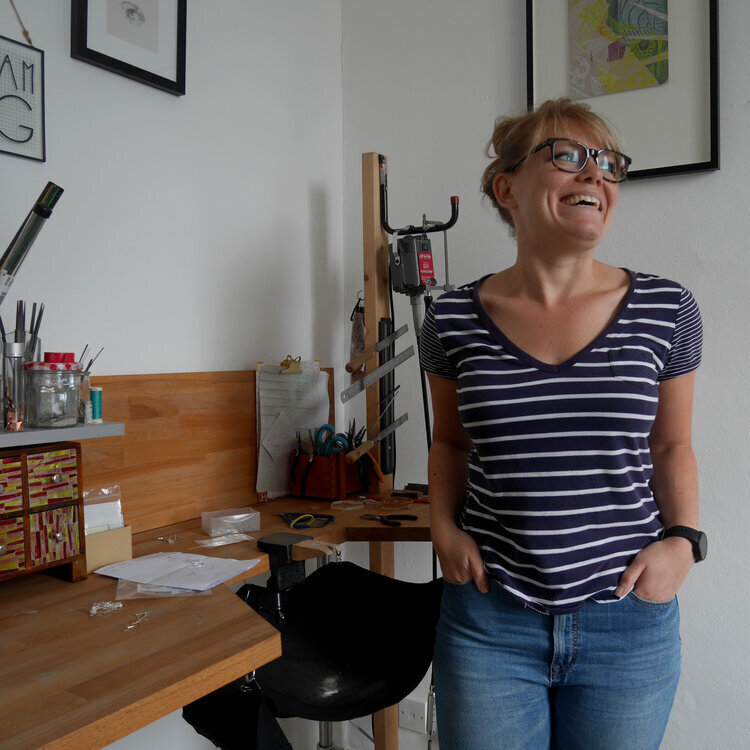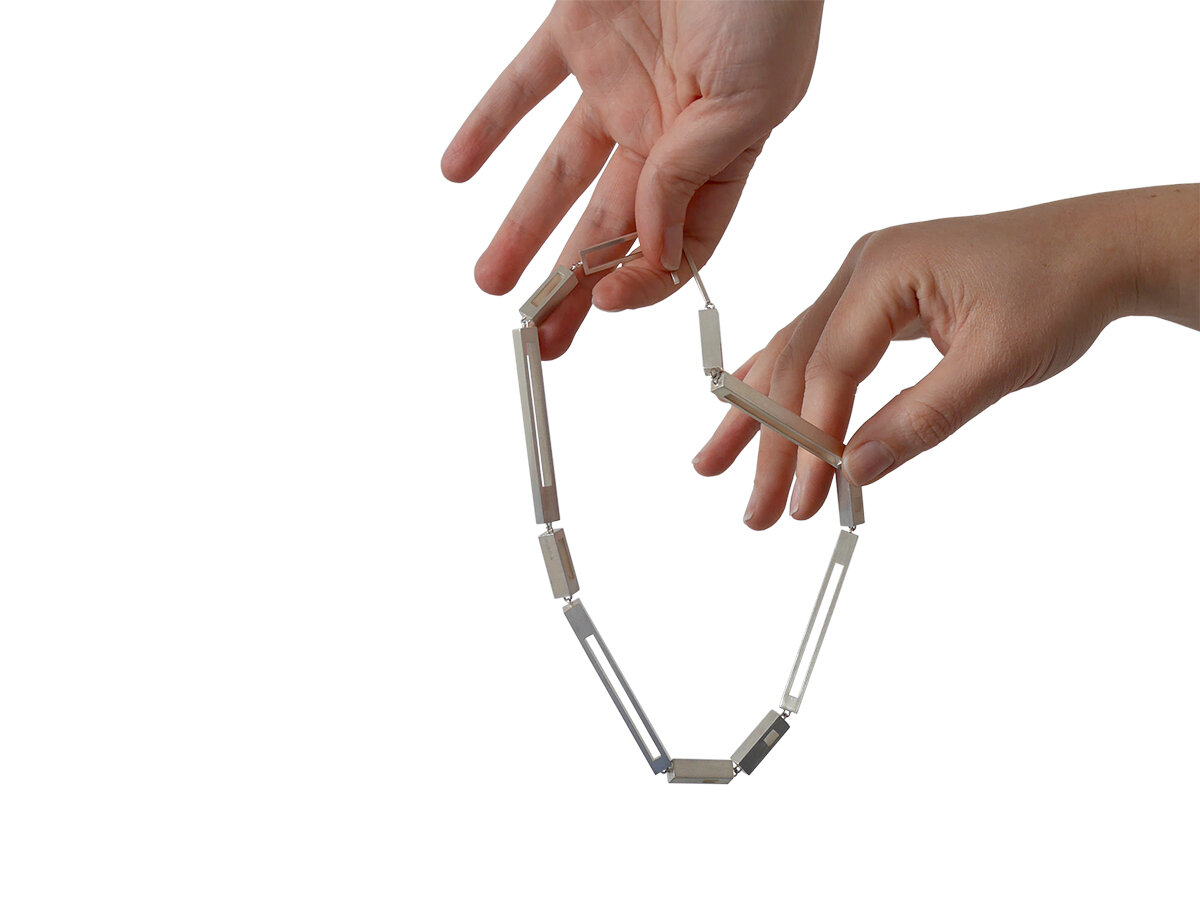hello february! we are well into the grind of 2021 now - and for an extra dose of creative stimulant i decided on a new series of blog posts. as you know i’m constantly looking for new things to look at, read and new people to know about so i figured you might feel the same after a busy january. therefore i am happy to publish the first in a series of conversations with designers, makers or craftspeople of all disciplines whose values or inspirations i share. my first virtual guest is kate mclaughlin, architect-turned-jeweller of align jewellery.
ZITA: hi! first of all, tell me a little bit about yourself, what you do and how you got there?
KATE: hi! i'm kate, and i'm a jeweller but my background is in architecture. i create architecturally influenced jewellery that is quite minimal, bold and uncompromising in its linear and geometric qualities. i studied architecture - i went straight from school to edinburgh college of art so it was very much "art school architecture" and we were really taught how to design over many many years and this is so deeply ingrained now. we were taught a kind of design process and we were just doing it over and over and over again to the point where i can't not do it.
ZITA: i think i know what you mean!
KATE: and after i studied architecture i went into practice and i realised that commercial architecture wasn't for me and my jewellery hobby kind of took over unintentionally, in a series of happy accidents. i didn't consciously decide to quit one and do the other but one faded in and one faded out. but that "drilling in of a design process" of being really critical, and analytical, and questioning everything - i couldn't make anything in any other way. when i explain to people that i was an architect, they always immediately understand, i guess it makes sense, aesthetically. but i think my process is also very influenced. and some of the tools i use came with me too: occasionally i think the easiest way to do it would be a CAD drawing. sometimes i still think of things as "plan, elevation, section", and i look at the different sides and draw an elevation of a piece of jewellery. i'm fairly sure that regular jewellers don't think like that or use those terms even! so there are layers of how it is architectural. does this make sense?
ZITA: yes, it totally does! and i like how you describe your work on your website and social media, that you call it "wearable architecture" and to me as well it signals that you haven't really shifted from that mindset. or was that not an easy shift? you talk about a gradual change, of one fading in and one fading out. did you find it easy?
KATE: the architect in me will always be there, it’s just how i earn money shifted, one eased in and one eased out. but actually, part of it was really really hard because i spent so long aspiring to be, and in a way fighting for architecture, that it's really, really hard to give up and walk away from all of that. actually, i still do a little bit of practice and a very little consultancy work for a local practice as well. part of it is keeping my hand in, but part of it is a comfort blanket thing... my last ten years strand back to my previous life!
ZITA: i understand that!
KATE: as for "the how easy it is" thing - i did, at one point, in my jewellery tried not to do architecture. at the time i think i was in a huff with it. i thought “nah, don't want to do that anymore”, i’d just turn my back on it and do something completely different. so what i was going to do was freeform and floaty and natural, and i made these things that were all organic and petal-like, and i didn't know how to make them into a piece of jewellery. so i made a box, to put the things in, and by the end of finishing the jewellery, i had kept the box and ditched the organic freeform things and had this really really geometric cage thing. so at that point i thought, oh, okay, so it's not a choice!
ZITA: wow! that's exactly what i was trying to get at, whether you can change your mindset or not. but you explained about your training how that's so deeply ingrained so i was wondering if it's even possible to get rid of that.
KATE: yeah i'm sure it's possible, i believe people and brains have the ability to re-learn but i don't know i if i want to re-learn badly enough to put in that effort.
ZITA: i can relate to that! and is there a particular style or school of architecture that you're inspired by or is it more about the space? is there anything very particular you look out for or have a "trained eye" for - or is it just space and form that really catches you?
KATE: i don't like subscribing to a particular school - what i really appriecate and notice are small parts. i’d never say "that's my favourite building" or style, but there are details. either really little, like a window surround, that little. or a specific view, or it's often about how different things meet. how a building meets where it is or how different materials meet each-other or how spaces meet each-other, it's that kind of intersection. and it's interesting and beautiful in really mundane architecture. if you notice those things you can see them all around you all of the time, even in what should be quite uninspiring places.
ZITA: oh yeah, that does absolutely resonate with me. i work like that too, i find patterns, not jewellery in the same forms, but i find the beauty in the same things too. i find rhythm and texture in cityscapes and gas tanks, cranes and places like that.
KATE: yes!
ZITA: and i guess where i find a pattern you find a spatial form?
KATE: yes, flat forms to me feel unsatisfying, i always try and find three-dimensional forms, which is what i mean about wearable architecture. when i'm out and about and looking, i get quite often drawn to textures. the rough, building material textures, do you know what i mean? concrete or things that are cracked or worn.
ZITA: oh yes i get that! me too.
KATE: i know that doesn't translate to my jewellery but when i come home with weird architectural photos it's quite often a textural thing!
ZITA: yes! that's interesting. i was just going to ask about that, would you consider using other materials? right now your jewellery is silver, isn't it?
KATE: it is!
ZITA: so do you look to expand or incorporate other materials in your work?
KATE: i would love to. i'm not sure what form it would take. and, i'm a also slightly wary, because if a new material was going to involve a new skillset, which really excites me and i really want to do, i would also see myself disappearing into a rabbit hole... and never coming back!
ZITA: yeah there’s always that danger.
KATE: but i'm interested in it and also there is a nice thing in taking something that's really common and everyday and making it into something that's really precious. like using concrete. or using found objects but setting them as if they were precious stones and making them feel as if they were really precious jewellery. actually, i've recently commissioned a lady who works with jesmonite to make me little props to take my photographs on, and they all have slightly different patterns on them. they are all super smooth and the texture is beautiful, and there are patterns in the colour - they are not just grey, they are really lovely and looking at them makes me think "woah i see the potential".
ZITA: that sounds really cool. so if other materials are not the immediate next step for you, then what is? what can we expect to see from you next?
KATE: so going back to the texture thing, at the moment texture doesn't really feature a lot in my work because i always thought it's about the form. it had to be about form and nothing else so texture hasn't really been in it, so texture is my next thing! it's been ongoing and i have a "shopping list" of some traditional and not so traditional things to experiment with. i don't know what it will look like in jewellery, so my next thing is a non-jewellery experiments on how to create different textures and maybe going back through my architectural close-ups and look into how i can re-create some of that. but step one will not involve any jewellery because it's less of a pressured way to do it! making it into jewellery will be step two.
ZITA: maybe you could exhibit your experiments as sculptures!
KATE: yes i would love my experiments to be a beautiful thing, even if it's only a “sketchbook” of samples. because then you could back to it over and over again and you might end up discovering loads of textures or loads of techniques so it might just be a case of keeping your records - so i would quite like whatever it is to be a beautiful thing to keep and go back to in the future.
ZITA: that sounds like a great plan!
KATE: i think that's quite achievable in lockdown, it's something i can do by myself in the studio so that's the immediate plan.
ZITA: and, having spoken about inspiration - does it find you spontaneously or do you go and actively research?
KATE: it is very spontaneous. when i go out and about and i see something i like i take a picture of it without thinking too hard why i like it or what i'm going to do with that, it's just a photo of a weird thing. i don't think it's any more than that, it's just like a gut instinct. often when i'm making i've been making it up as i go along more. sometimes things just take a turn as you're making, and you see an opportunity and follow your nose. i do have collections that are way more thought out and involved a lot more research. they were a bit more engineered in a way, i thought about how a collection of pieces sit together, but it's been a while since i worked like that and i've been thinking recently that maybe i need to go back to working like that.
ZITA: thinking about research - and this is something i want to ask from everyone i have these conversations with - can you recommend a book, or recommend someone whose work you find inspiring?
KATE: the person i'm going to recommend to you is karlyn sutherland, and she is a glass artist. i studied with her so she also started out in architecture. she did a phd and in it she looked to place and it lead her to glass, she made glass art about place as part of her architecture phd. she is a world renowned glass artist and her work is really architectural. it's really amazing and deceptively simple. you would really have to look to understand - you should definitely, definitely look her up.
ZITA: thanks, that's great! i’ll check her work out. i'm a bit of a design junkie and it's why i want to ask from everyone, i love discovering new work and it also says a lot about the person recommending it i think what they find most interesting.
KATE: that's a good question to ask!
ZITA: and the very last one - apart from your own website, where else can my readers find your work or buy your jewellery?
KATE: right now, a lot of my stockists are shut obviously. hopefully you can find my work at yorkshire sculpture park, as part of their made exhibition - whenever they're allowed to open back. and just yesterday i found out that i've been given a place at the digital craft festival which is happening at the last weekend of march (26th - 28th). so you can find my work through that!
ZITA: brilliant! i think that's an excellent news to close this with! thank you so much for your time, i think it’s been a meaningful and inspiring conversation, and i hope to speak in person some time.
KATE: thanks!
-
links:
Kate McLaughlin - maker profile on Craft Scotland




